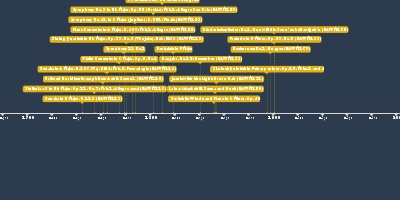jan 1, 1788 - Symphony No. 41 in C Major (Jupiter), K. 551: Finale (NAWM 123)
Description:
Composer: Wolfgang Amadeus MozartGenre: Symphony
In Viennese tradition, C major symphonies were for celebrations of births, weddings, and name days of members of the emperor’s family. Thus this symphony features fanfares, flourishes, and dotted rhythms. The name “Jupiter” was bestowed upon the piece in Britain by 1819, linking it to highest Roman god and implying that it represents the summit of musical achievement.
Finale
This movement expertly merges the sonata form procedures of Mozart’s time with the eighteenth century counterpoint and fugue.
Exposition
The first theme demonstrates how Mozart liked to have multiple ideas within one theme. These ideas (motives) will be played with and molded for the rest of the piece. The first theme begins (a) in a singing galant style with a murmuring accompaniment. It then continues (b) in a lighter style marked by repeated staccato notes and a sweeping descending sixteenth note figure.
Exemplifying expert counterpoint, the transition begins with a motive in a five-voice fugato, and both the transition and second themes are steeped in imitation.
The second theme also demonstrates a multiplicity of ideas, with a lyrical motive in violin 1 and a short staccato countermotive in the oboes.
Development
Focuses and modulates a ton with a couple motives from the exposition.
Recapitulation
The first theme is shortened.
Coda
Begins with contrasting statements of previous motives. He then brings back nearly all of the previous motives (five in all) and combines them in fully invertible counterpoint. Thus the motives can appear in any voice, and most impressively any of them can serve as the bass.
So, Mozart brought these essentially galant-style ideas together into a perfectly strict fugue, staging a reconciliation between the learned and galant styles.
Added to timeline:
Date:
jan 1, 1788
Now
~ 237 years ago
